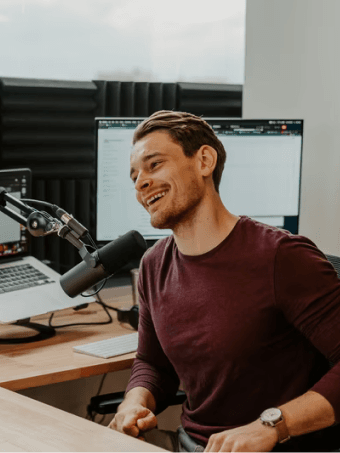What are Trademarks?
Trademarks are signs, symbols, brand names, and visual elements capable of distinguishing the goods and services of one company from the goods and services of other company. They're essentially brand identifiers that are supposed to prevent customer confusion and protect the reputation a certain brand has garnered.
The three most commonly used types of trademarks are textual trademarks, graphical trademarks, and combined trademarks (text + visual elements). Additional, less common types of trademarks include shapes, sounds, colors, and any other elements that can be used to distinguish your brand from others.
However, without being registered, trademarks don't hold much power on their own. Trademark registration is a key step in protecting a company's intellectual property rights. Registered marks discourage infringement attempts and provide owners with the ability to oppose registration attempts of any similar trademarks.
How Media Companies Use Trademarks
Large media companies like Netflix, Disney, and HBO treat trademarks as strategic assets. They proactively register marks early, guard them through enforcement, and use them to shape public perception and business expansion.
The Case of Netflix
Netflix proactively registers a lot of trademarks, including ones that are related to the fictional universes of its shows. For example, Space Force and the Hellfire Club were registered across Europe, Australia, and Mexico before the show ever aired. These forward-thinking filings ensure control over merchandising and branding, avoiding conflicts and confusion.
But even with their proactive approach, Netflix has gotten themselves into hot water quite a couple of times. For instance, Netflix faced a $25 million trademark lawsuit over the use of the phrase “Choose Your Own Adventure” in Black Mirror: Bandersnatch. At first, Netflix tried to fight the lawsuit, aruging fair use and First Amendment protection, but ultimately settled after a lengthy litigation.
On the other hand, when a Chicago bar launched a Stranger Things–themed pop‑up called "The Upside Down," Netflix sent a whimsical cease‑and‑desist, fully in brand voice: “Look, I don’t want you to think I’m a total wastoid, but...” The letter then politely asked the bar to wrap up its pop-up and "reach out to us for permission next time." The tone endeared Netflix to fans and earned praise for handling enforcement with humor.
The Case of Disney+
From logo shapes to trade dress and even public domain imagery, Disney actively and aggressively monitors and defends usage, including early-stage filings (like forms of Mickey) and post-public-domain appropriations. Additionally, Disney employs a layered system of protection by weaving copyrights and trademarks together. Even when copyrights expire, trademarks ensure control over key visual symbols and brand identity.
This was even in the case when Disney challenged electronic artist deadmau5 (Joel Zimmerman) over his iconic “mau5head” logo when he filed for U.S. trademark protection. Disney argued that it infringed upon its own Mickey Mouse trademark and officially opposed the application. Zimmerman then countersued, alleging Disney used his song without permission. The case was allegedly settled amicably out of court with both parties being satisfied with the outcome.
Interestingly, Disney's IP tactics and their case against Air Pirates even scared off future parody artists. This 1970s saga involved underground cartoonists (the Air Pirates) parodying Mickey Mouse in adult-themed comic books. Disney won in court, obtaining injunctions and significant damages. The case established that faithful reproductions could infringe both copyright and trademark rights, even when they're used as satire.
The Case of HBO
In general, HBO moves quickly to file trademarks on terms the public is viralizing right after episodes air. Examples of this include the famous “WINTER IS COMING” and “HODOR” lines from Game of Thrones. They actively police unauthorized uses of their trademarks and trade dress, sending cease‑and‑desist letters, opposing filings, and contesting infringers—even in smaller markets. Beyond words, HBO has been defending packaging, visual identity, and product design to preserve brand integrity for years.
However, they have experienced some difficulties with trademarking the HBO Max brand name across various jurisdictions. In the Benelux region, HBO withdrew its intention to use just “MAX” after Omroep Max, a local broadcaster, objected; HBO agreed to retain “HBO Max” exclusively in that market. Additionally, In the U.S., Traxxas (the RC toy maker) filed an opposition challenging HBO’s expansion of “HBO Max” into toy/game classes; the challenge is still pending.
Beyond just company disputes, HBO have also pursued fan-made merchandise pertaining to their intellectual property. For example, in 2013, Fernando Sosa, a fan designer created a 3D-printed iPhone dock resembling the iconic Iron Throne from Game of Thrones. He subsequently offered it for sale on his site. HBO swiftly moved with a cease & desist letter, ordering Sosa to remove all online references to the design. This situation was a clear example of how major media companies vigorously protect their property—even in quirky, fan-driven scenarios.
Takeaways
Proactive vs. reactive strategy Media giants file trademarks ahead of content releases, in order to secure their rights beforehand and make the enforcement easier down the line. This is a strategy that applies not only to corporate giants, as every business should strive to secure their IP before things escalate.
Enforcement shapes brand perception Netflix’s humorous style and HBO’s firm boundaries illustrate that tone matters—enforcement can build goodwill or deter infringers depending on how it's done. Not taking action against infringement, on the other hand, can have lasting negative consequences on the brand. That's why it's important to know how to identify infringement and act on it.
Layered IP protection matters Disney’s use of both copyright and trademark ensures control over iconic imagery long after the original work enters the public domain.
Small and big players face IP challenges Even large companies like Disney and HBO must defend their marks globally, navigating opposition and local regulations.
FAQs - How Media Companies Handle Trademarks
1. Why do media companies file trademarks for fictional phrases even before a show airs?
They anticipate commercial usage—merchandising, licensing, and brand protection—and by securing trademarks early, they ensure control over future exploitation and block imposters before they appear.
2. What is ‘trade dress’ in the context of shows or streaming platforms?
Trade dress refers to the visual appearance or design of a product or its packaging—in media, this can include show titles, recurring slogans, or even set designs. HBO and Netflix defend trade dress the same way product brands do, to prevent audience confusion.
3. Can a fan-made item like a 3D-printed prop be taken down by the show’s owner?
Yes. Even when it seems harmless, fan merchandise can infringe trademarks (or copyrights). HBO’s swift action on the Iron Throne dock is a prime example of how media companies enforce IP protection against unofficial merch.


